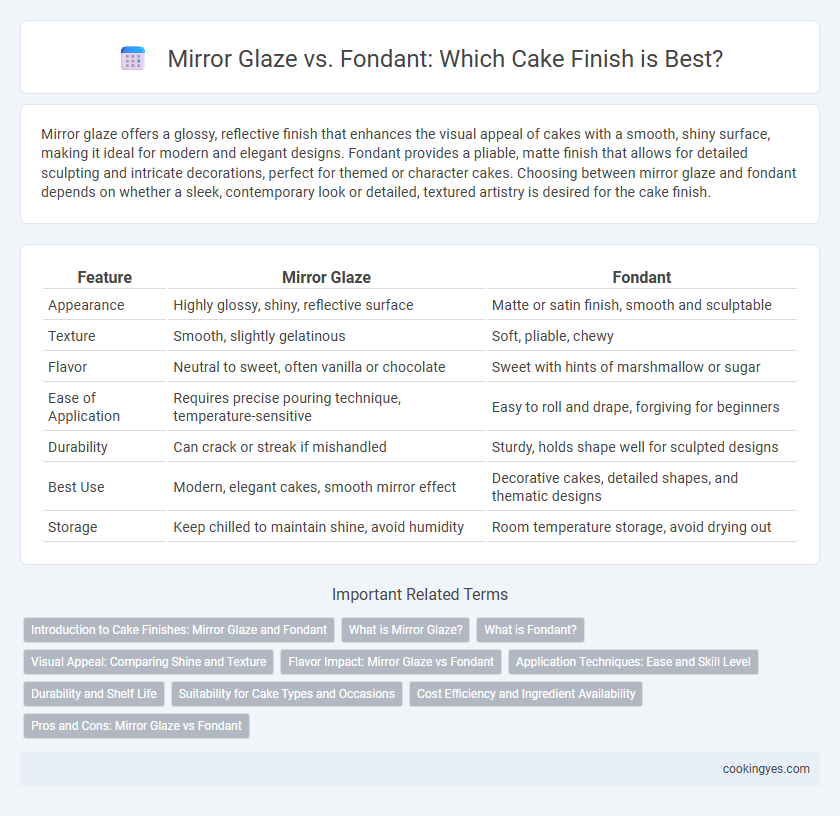Mirror glaze offers a glossy, reflective finish that enhances the visual appeal of cakes with a smooth, shiny surface, making it ideal for modern and elegant designs. Fondant provides a pliable, matte finish that allows for detailed sculpting and intricate decorations, perfect for themed or character cakes. Choosing between mirror glaze and fondant depends on whether a sleek, contemporary look or detailed, textured artistry is desired for the cake finish.
Table of Comparison
| Feature | Mirror Glaze | Fondant |
|---|---|---|
| Appearance | Highly glossy, shiny, reflective surface | Matte or satin finish, smooth and sculptable |
| Texture | Smooth, slightly gelatinous | Soft, pliable, chewy |
| Flavor | Neutral to sweet, often vanilla or chocolate | Sweet with hints of marshmallow or sugar |
| Ease of Application | Requires precise pouring technique, temperature-sensitive | Easy to roll and drape, forgiving for beginners |
| Durability | Can crack or streak if mishandled | Sturdy, holds shape well for sculpted designs |
| Best Use | Modern, elegant cakes, smooth mirror effect | Decorative cakes, detailed shapes, and thematic designs |
| Storage | Keep chilled to maintain shine, avoid humidity | Room temperature storage, avoid drying out |
Introduction to Cake Finishes: Mirror Glaze and Fondant
Mirror glaze creates a glossy, reflective surface using a mixture of gelatin, sugar, and condensed milk that enhances the cake's visual appeal with vivid colors and a smooth finish. Fondant offers a pliable, dough-like texture made from sugar, water, and gelatin, allowing for intricate designs and a matte or slightly shiny appearance. Both finishes provide distinct aesthetics and textures, influencing the cake's presentation and taste experience.
What is Mirror Glaze?
Mirror glaze is a shiny, reflective coating made from a mixture of gelatin, sugar, water, and condensed milk that creates a smooth, glass-like finish on cakes. It is poured over chilled cakes to achieve a flawless, glossy surface that enhances visual appeal and highlights cake colors and decorations. Unlike fondant, mirror glaze has a wet, silky texture that adds moisture and a delicate sweetness without the dense, pliable consistency.
What is Fondant?
Fondant is a pliable sugar paste used to create a smooth, polished finish on cakes, often favored for its ability to be molded into intricate shapes and decorations. Made primarily from sugar, water, and gelatin or glycerin, fondant provides a matte or slightly shiny surface that can be tinted with various colors. Unlike mirror glaze, fondant offers a thicker texture and is ideal for sculpted designs and detailed cake artistry.
Visual Appeal: Comparing Shine and Texture
Mirror glaze delivers a glossy, reflective surface with a smooth, glass-like finish that enhances the cake's visual sophistication. Fondant offers a matte or slightly satin texture that can be molded into intricate shapes, providing versatility in design but lacks the high-shine allure of mirror glaze. For vibrant, mirror-like reflections and a sleek appearance, mirror glaze excels, while fondant excels in creating textured, detailed decorations with a softer look.
Flavor Impact: Mirror Glaze vs Fondant
Mirror glaze delivers a glossy, smooth finish with a subtle sweetness that enhances the cake's flavor without overpowering it, allowing the cake's core taste to shine through. Fondant provides a denser, sweeter coating that can sometimes mask the cake's natural flavors due to its heavier sugar content. Choosing mirror glaze over fondant often results in a more balanced flavor profile and a lighter eating experience.
Application Techniques: Ease and Skill Level
Mirror glaze requires precise temperature control and a smooth cake surface to achieve a flawless, shiny finish, making it more suitable for experienced bakers. Fondant is easier to apply with basic rolling and smoothing skills, providing a polished look even for beginners. Choosing between them depends on desired aesthetics and the baker's comfort with handling delicate textures.
Durability and Shelf Life
Mirror glaze offers a glossy, smooth finish that is less durable than fondant, as it can be prone to cracking or melting at room temperature. Fondant provides a thicker, more flexible covering that enhances cake durability by protecting it from air and moisture, extending shelf life significantly. Cakes finished with fondant typically maintain freshness for up to two weeks, while mirror glaze cakes are best consumed within a few days to preserve optimal appearance.
Suitability for Cake Types and Occasions
Mirror glaze offers a sleek, glossy finish ideal for mousse cakes and entremets, enhancing their delicate textures and elegant presentation, making it perfect for modern, sophisticated events like weddings or upscale parties. Fondant provides a smooth, pliable covering suitable for shaping and intricate decorations, excelling on traditional sponge or butter cakes and favored for birthday cakes and themed celebrations due to its versatility in customization. Choosing between mirror glaze and fondant depends on the cake type and occasion, with mirror glaze emphasizing visual impact and fondant allowing detailed artistic designs.
Cost Efficiency and Ingredient Availability
Mirror glaze offers a cost-efficient cake finish using basic ingredients like gelatin, sugar, and condensed milk, which are commonly available and inexpensive. Fondant, while requiring specialized ingredients such as gelatin, glycerin, and food-grade glucose, tends to be pricier and sometimes harder to source in certain regions. Choosing mirror glaze can reduce overall ingredient costs and simplify procurement without sacrificing a glossy, professional appearance.
Pros and Cons: Mirror Glaze vs Fondant
Mirror glaze offers a shiny, reflective finish that creates a visually stunning cake surface, enhancing the appeal for special occasions. It sets quickly and provides a smooth texture but is delicate and prone to scratching or melting in warm conditions, requiring careful handling and refrigeration. Fondant, while less glossy, offers versatility for detailed decorations and a thicker, protective layer that is more stable at room temperature but can taste overly sweet and feel dense compared to the light, silky mouthfeel of mirror glaze.
Mirror glaze vs Fondant for cake finish Infographic

 cookingyes.com
cookingyes.com